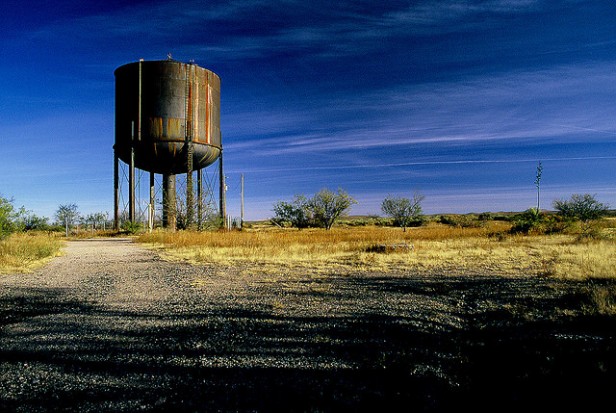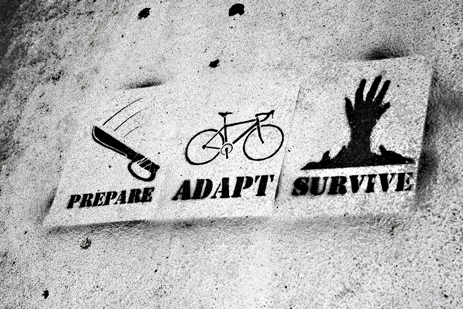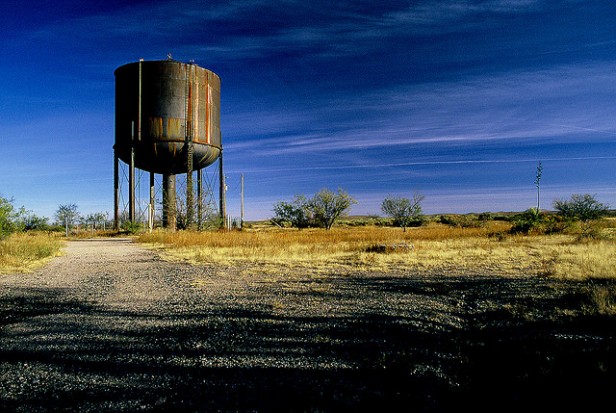 For sale? An old water tower in Hachita, New Mexico.Photo: Ryan Thomas
For sale? An old water tower in Hachita, New Mexico.Photo: Ryan Thomas
The history of the West is peppered with water cowboys. Just recall William Mulholland, whose role in Los Angeles’ secret grab of water from Owens Valley, Calif., was made famous in the movie Chinatown, or Colorado’s contemporary water baron, Aaron Million, who’s pushing a $3 billion, privately funded scheme to funnel water to Colorado’s Front Range. Experience has shown that with water comes power.
The unique properties of water — the fact that it is a limited resource required for survival and that it has no substitute — have made it a bitterly fought-over asset in the arid West. Westerners who want to protect their limited water supply realize how important it is to keep this public resource out of the hands of the water cowboys.
But a threat different from diversion has come to town. As communities struggle to balance their ever-shrinking budgets, investment firms and large, predominantly foreign companies are seizing the moment. Across the country, communities are being aggressively courted to sell or lease their drinking water and wastewater utilities to private companies. Since 1991, water utilities interested in profit have seduced at least 144 cities and towns into privatizing their domestic water systems. Most were in the nation’s Rust Belt. But this year, a record number of communities are considering it, including some in the West: Tulsa, Okla., Fresno County and Rialto, Calif., and Comal County, Texas, are all considering privatization.
But before they answer the siren call of private water companies, Western cities should heed the experiences of other communities. Because after the jolt of cash that comes when a city leases or sells its water utility, benefits drop off — sometimes precipitously. In the 10 largest cities around the country that have sold or leased their water systems, companies have raised consumers’ water rates by an average of 15 percent a year. Residents of Fairbanks, Alaska, saw their water and sewer bills jump from $543 a year before the utilities were sold in 1997, to $1,197 today, an increase of 9 percent annually. Residents of East Palo Alto, Calif., have seen their bills rise by 10 percent a year since their water system was leased to the for-profit company, American Water.
Luckily, as in all good Westerns, rebels abound. In the last two years alone, at least 18 cities across the country have terminated contracts with private water companies, usually because of poor service or increasingly high rates. The cities have learned that private companies often cut costs by eliminating jobs and delaying maintenance. Inevitably, this leads to service problems, while pressure to boost shareholder returns often leads to an increase in water rates for residents.
In every one of these 18 cities, bringing the utilities back under public control saved big money — an average of 21 percent of operating costs. After Petaluma, Calif., terminated its water contract with the Veolia company in 2008, the estimated savings amounted to nearly $1.6 million during the first three years of public operation.
Some Western cities have refused to be roped in by the new water cowboys. Last November, San Jose, Calif., ruled out privatizing its water system after determining that it would be 30 percent more expensive to do so than to keep the system public. In 2008, Reno, Nev., rejected a bid from Goldman Sachs to lease its water system, which serves over 300,000 people. Yes, that Goldman Sachs: The company whose executives welcomed the subprime mortgage crisis with the line, “Sounds like we will make some serious money,” is also getting into the water business, as are other investment firms.
As low-risk investments go, water is gold. It will always be needed and will inevitably become more valuable as population growth and climate change deliver their one-two punch. Buying utilities outright or urging cities to sign long leases — some as long as 99 years — is one way for investors to secure control over limited water supplies.
But when for-profit companies commandeer our drinking water and sewer systems, they take control of all the key decisions: How much will consumers pay for water? When will the pipes, reservoirs and treatment plants be upgraded? Will conservation efforts cease because they’re too expensive?
Western cities should not be fooled by the promise of quick cash that comes with water privatization. They may not wear black hats, but water cowboys are easy to spot. It’s up to the honest citizens of the West to keep their hand on the spigot.
This post first appeared in High Country News’ Writers on the Range series, republished with permission.



